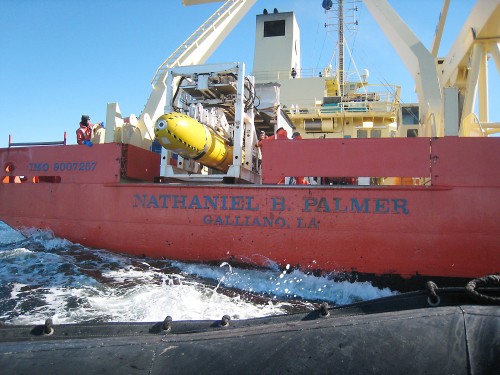We just posted an article talking about the delicate balance that the West Antarctic Ice Shelf is under, and how a scientist wished he could look under the shelf to see what was happening. His wish is a team of British and American scientists command. They have successfully deployed an autonomous robot submarine on six missions beneath an Antarctic ice shelf using sonar scanners to map the seabed and the underside of the ice as it juts out over the sea.
The research is part of a larger, National Science Foundation-funded project to study the dynamic Pine Island Glacier and to understand how increasing ocean temperatures triggered by a warming climate may affect the melting of the West Antarctic Ice Sheet (WAIS) and global sea-level rise.
“There is still much work to be done on the processing of the [submarine] data”, said Adrian Jenkins of British Antarctic Survey, “but the picture we should get of the ocean beneath the glacier will be unprecedented in its extent and detail. It should help us answer critical questions about the role played by the ocean in driving the ongoing thinning of the glacier.”
Scientists hope to learn why the glacier has been thinning and accelerating over recent decades. Pine Island Glacier is in the Amundsen Sea, part of the Southern Ocean bordering West Antarctica. Changes in its flow have been observed since the early 1970’s, and together with neighboring glaciers it is currently contributing about 0.25 mm (less than one-tenth of an inch) annually to global sea level rise. But the ice shelf, like other ice shelves, serve to hold back movement of the West Antarctic Ice Sheet.
The lead U.S. researcher on the project, Stan Jacobs, of the Lamont-Doherty Earth Observatory at Columbia University, is conducting long-term observations of the Pine Island Glacier, most recently with International Polar Year (IPY) funding from NSF. NSF is the lead U.S. agency for IPY research. The World Meteorological Organization (WMO) and the International Council for Science (ICSU), which planned and sponsored IPY, has set aside the last two weeks of March to recognize projects that focus on the polar oceans.
One of NSF’s IPY research goals is to better understand the dynamics of the world’s massive ice sheets, including WAIS, which, if it were to melt all at once, would raise global sea level by five meters (16 feet). Destroying or severely damaging most major sea side cities in the world.
The most recent report of the Intergovernmental Panel on Climate Change (IPCC) noted that because so little is understood about ice-sheet behavior it is difficult to predict how ice sheets will contribute to sea level rise in a warming world. The behavior of ice sheets the IPCC report said is one of the major uncertainties in predicting exactly how the warming of the globe will affect human populations.
Jacobs and Jenkins deployed the robot explorer, Autosub3, from the NSF-chartered R/V Nathaniel B. Palmer, to investigate the underside of the ice shelf and measure changes in salinity and temperature of the underlying water.
Autosub3 was built and developed by the National Oceanography Centre in the United Kingdom, a collaboration between the University of Southampton and the Natural Environment Research Council.
After a test mission in unusually ice-free seas in front of the face of the glacier, the researchers started with three 60-kilometer (37-mile) round-trip forays under the floating ice shelf and extended the length of missions to 110km (68-mile) round trip. In all, more than 500km (310 miles) of the ocean beneath the ice was profiled.
Steve McPhail led the Autosub team during the ten-day survey.
He said that “Autosub is a completely autonomous robot: there are no connecting wires with the ship and no pilot. Autosub has to avoid collisions with the jagged ice overhead and the unknown seabed below, and return to a pre-defined rendezvous point, where we crane it back onboard the ship.”
“Adding to the problems are the sub zero water temperatures and the crushing pressures at 1000 meters depth. All systems on the vehicle must work perfectly while under the ice or it would be lost. There is no hope of rescue 60 km in, with 500 meters of ice overhead.”
Autosub3 has a maximum range of 400km (248 miles) and is powered by 5,000 ordinary D-cell batteries. The batteries are packed in bundles in pressure-tested housings. At either end of the seven-meter (22-foot) sub there are free-flooding areas where the payload of instruments are installed.
Using its sonar, the Autosub3 picks its way through the water, while creating a three-dimensional map that the scientists will use to determine where and how the warmth of the ocean waters drives melting of the glacier base.
Complementing the Autosub exploration, other work during the 53-day cruise included setting out 15 moored instrument arrays to record the variability in ocean properties and circulation over the next two years, extensive profiling of ‘warm’ and melt-laden seawater, sampling the perennial sea ice and swath-mapping deep, glacially-scoured troughs on the sea floor.
I find this pretty awesome, using robots to explore places like this on earth could one day lead to us using similar robots to explore other places in our solar system that share a similar cold liquid profile (several moons of Saturn and Jupiter fit the bill). Lets hope they find the valuable scientific data that we need to help us avert a global warming catastrophe.
